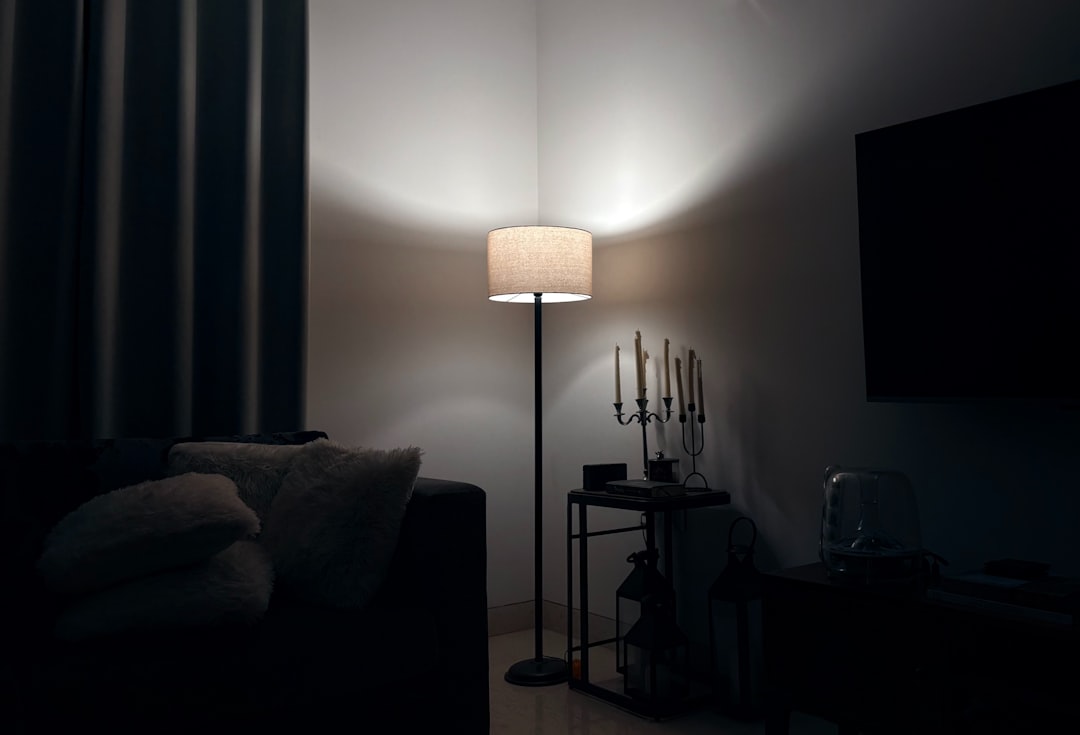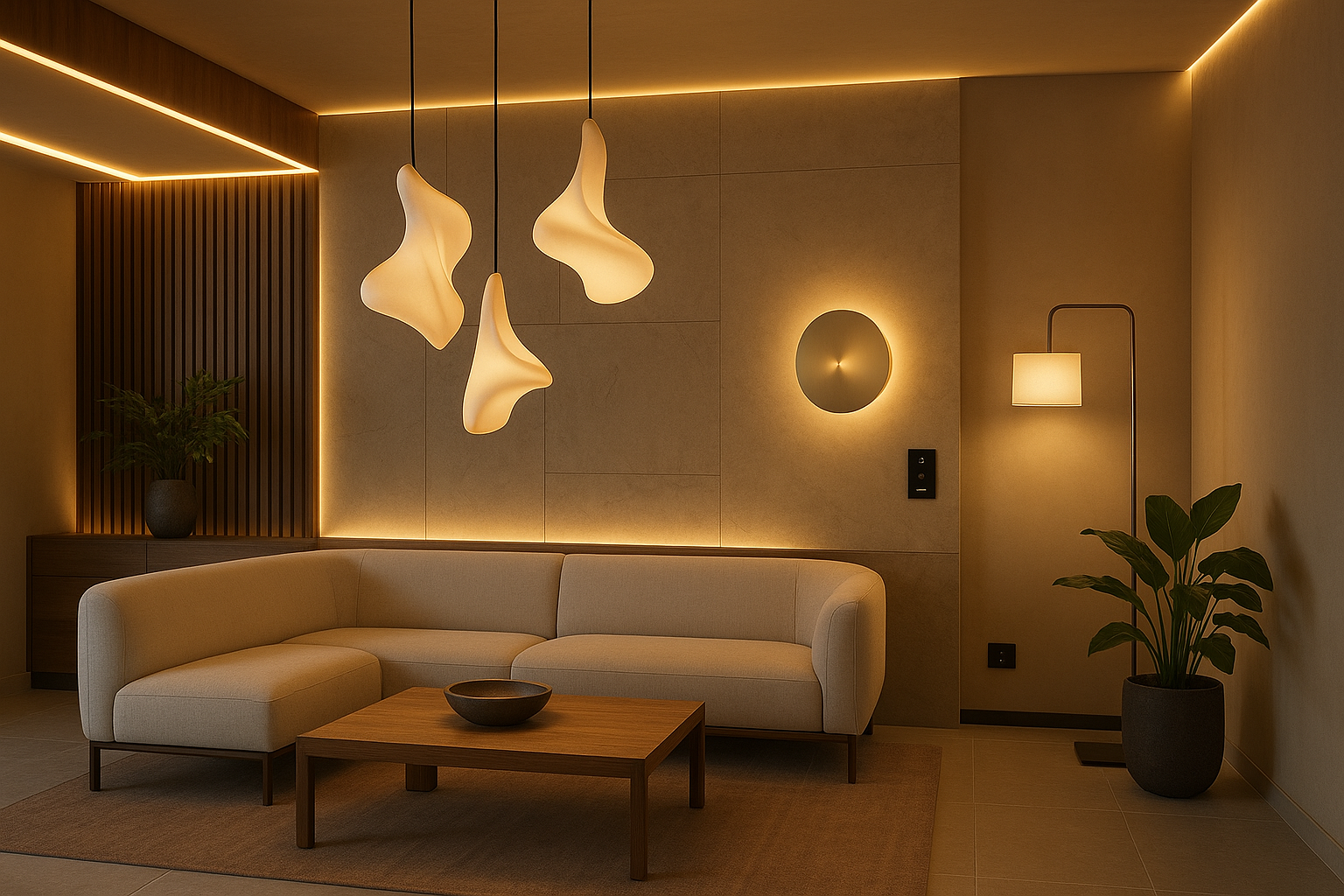The Ultimate Guide to Layered Lighting: Transform Your Home with Ambient, Task, and Accent Light
Lighting has the power to change everything about a room—how it looks, how it functions, and how it makes you feel. Whether you’re cooking dinner, curling up with a book, or getting ready for bed, the right lighting enhances the moment. At the center of great lighting design is layered lighting—a thoughtful mix of ambient, task, and accent light that blends beauty with practicality.
Key Takeaways
- Layered lighting combines ambient, task, and accent lighting to create functional and inviting spaces.
- Ambient lighting provides general illumination and sets the room’s foundational mood.
- Task lighting targets specific activities, enhancing focus and reducing eye strain.
- Accent lighting adds drama by highlighting art, architecture, and design features.
- Using separate circuits and dimmers allows flexible control of each light layer.
- Matching color temperature to each room’s purpose ensures comfort and clarity.
- Emerging trends such as wireless fixtures and smart lighting systems offer modern convenience.
Table of Contents
- What Is Layered Lighting and Why It Matters
- Ambient Lighting: The Foundation of Every Room
- Task Lighting: Focusing Light Where You Need It Most
- Accent Lighting: Adding Drama and Highlighting Details
- Layered Lighting in Different Rooms: Tailored Solutions for Every Space
- Technical Tips to Perfect Your Layered Lighting Design
- Emerging Trends in Layered Lighting
- Final Thoughts: Layered Lighting as the Key to Stylish, Functional Interiors
- FAQ
1. What Is Layered Lighting and Why It Matters
Layered lighting brings together three essential types of light to create a space that’s both functional and flexible:
- Ambient Lighting: The general, overall light that fills a room, allowing you to move around safely and comfortably.
- Task Lighting: Targeted lighting for specific activities like chopping vegetables, reading, or grooming.
- Accent Lighting: Decorative light that highlights architectural features, art, or design elements to create visual interest and depth.
A single overhead bulb can leave a room feeling flat or sterile. Layering light, on the other hand, introduces dimension and warmth, so the space adapts to different needs throughout the day.
Why Layered Lighting Is Worth It
- Boosts mood and sets the tone — soft ambient light promotes relaxation, while bright task light aids concentration.
- Improves usability — each layer serves a clear function, reducing strain and improving efficiency.
- Creates focal points — accent lighting draws attention to what matters most in a room.
- Offers flexibility — control each layer independently to tailor the ambiance for work, rest, or entertaining.
In short, layered lighting doesn't just illuminate—it elevates.
2. Ambient Lighting: The Foundation of Every Room
Ambient lighting acts as the base layer in any lighting plan. It provides consistent, even illumination across the space, reducing harsh shadows and ensuring visibility.
Key Features of Ambient Lighting
- Typically comes from overhead sources such as chandeliers, flush-mount fixtures, pendant lights, or recessed can lights.
- Should distribute light evenly to avoid dark corners or overly bright zones.
- Serves as a canvas, laying the groundwork for task and accent lighting.
Tips for Achieving Great Ambient Light
- Layer several light sources instead of relying on one fixture. This prevents glare and harsh contrasts.
- Choose warm color temperatures (2200K–2700K) in cozy areas like bedrooms and living rooms.
- For kitchens and bathrooms, where visibility is key, aim for cooler temperatures (4000K–5000K) that simulate daylight.
- Install dimmer switches to easily adjust intensity based on time of day or activity.
Take the living room: recessed lights with dimmers can provide ample brightness for daytime activities and a gentle glow for evening wind-downs.
Explore techniques for ambient lighting
3. Task Lighting: Focusing Light Where You Need It Most
While ambient light creates an overall glow, task lighting delivers focused illumination right where it's needed. Whether you're slicing vegetables or flipping through a novel, task lighting improves precision while minimizing eye fatigue.
Where Task Lighting Shines
- Kitchens: Under-cabinet LEDs brighten counters; pendants over islands direct light downward without glare (stay 75cm or more above surfaces).
- Living Rooms: Table lamps or floor lamps beside seating offer localized light for reading or working.
- Bedrooms: Bedside lamps or wall-mounted reading lights illuminate without disturbing partners.
- Bathrooms: Vanity fixtures placed on either side of mirrors eliminate facial shadows for grooming or makeup.
How to Get Task Lighting Right
- Avoid glare by shielding bulbs and positioning fixtures to direct light away from the eyes.
- Use adjustable arms or swiveling heads where possible to customize lighting angles.
- Opt for LED bulbs—they’re long-lasting, cool to the touch, and energy-efficient.
In the kitchen, for instance, combining recessed lighting (ambient), under-cabinet lights (task), and pendant fixtures (accent) ensures workspaces are bright and shadow-free.
Discover more about effective task lighting
4. Accent Lighting: Adding Drama and Highlighting Details
Accent lighting is the final, expressive layer of the trio. It calls attention to what you love in a space—art, plants, architecture—and gives rooms texture and richness.
Common Types and Uses of Accent Lighting
- Directional spotlights or picture lights emphasize artwork or sculptures.
- Wall sconces and LED strips outline alcoves, mirrors, or built-ins.
- Wireless and rechargeable lamps provide flexible accenting without the commitment of wiring.
Accent light makes a space feel curated. For example, installing LED strips behind a bed’s headboard adds a soft, ambient glow that enhances mood and style.
Accent Lighting Best Practices
- Keep brightness 10 times higher than ambient light on focal objects to draw the eye effectively.
- Angle fixtures carefully to avoid glare or shadows.
- Pair accent lighting with ambient and task layers to create a cohesive look.
Lightweight, rechargeable options are especially popular for renters or retrofits—no hardwiring, all the ambiance.
5. Layered Lighting in Different Rooms: Tailored Solutions for Every Space
Each room has unique lighting needs. Here’s how to apply layered lighting principles to different parts of your home.
Kitchen Lighting Layers
- Ambient: Recessed downlights provide general coverage.
- Task: Under-cabinet lights for counters, pendants over islands for prep space.
- Accent: LED strips behind shelving or under toe kicks can subtly define features and add height.
Use separate circuits for each layer so you can adjust lighting as needed—bright for prep, soft for mealtimes.
Living Room Lighting Layers
- Ambient: Wall-mounted fixtures or central chandeliers spread general light.
- Task: Lamps near seating areas support focused activities.
- Accent: Sconces or picture lights highlight collections, art, or architectural details.
Portability matters here—wire-free lamps let you bring light to where it’s needed most.
Bedroom Lighting Layers
- Ambient: Dimmable overhead lights or flush mounts provide a flexible foundation.
- Task: Reading lights mounted on the wall or bedside table allow focused light.
- Accent: Headboard lighting or wardrobe LEDs add subtle ambiance.
Stick to warm-tone bulbs (2200K–2700K) to encourage restful evenings.
Bathroom Lighting Layers
- Ambient: LED overhead panels distribute light evenly.
- Task: Vertical fixtures flanking mirrors eliminate facial shadows for grooming tasks.
- Accent: Sconces or strip lighting around shelving or tubs introduce warmth.
Remember to select fixtures rated for damp or wet areas to ensure safety and longevity.
View layered lighting tips for bedrooms and kitchens
6. Technical Tips to Perfect Your Layered Lighting Design
Beyond choosing beautiful fixtures, the right technical setup makes all the difference in usability and impact.
Use Separate Circuits
Put each lighting layer on a dedicated circuit. This lets you:
- Brighten task areas without lighting the entire space.
- Activate just accent lights for a softer, evening ambiance.
- Combine layers when maximum illumination is needed.
In kitchens especially, consider wiring ambient, task, and accent lights independently for total flexibility.
Install Dimmer Switches
Dimmers enable seamless transitions from high-energy brightness to subtle evening glow:
- Choose dimmers compatible with the specific LED bulbs you’re using.
- Use separate dimmers for each lighting layer.
- Consider smart dimmers with app or voice control for added convenience.
Mind Fixture Placement
- Mix fixture heights—combine ceiling lights with wall and table-level options to avoid flatness.
- Angle task lights so they don’t cast shadows on key work areas.
- Use layering not just in function, but in literal light levels and height.
Match Color Temperature to Room Purpose
- Stick with warmer temperatures (2200K–2700K) in bedrooms and living rooms to promote relaxation.
- Use cooler temperatures (4000K–5000K) in kitchens and bathrooms for brightness and clarity.
7. Emerging Trends in Layered Lighting
- Wireless, rechargeable fixtures: Ideal for renters or challenging spaces, offering style without installing new wiring.
- Smart lighting: Set lighting scenes on a schedule or by voice, adjusting layers to fit your day.
- Mixed fixture types: Moving beyond uniform recessed grids toward stylistic variety improves depth and personalization.
- Linear and concealed LED lighting: Adds sleek modern touches and gives the illusion of openness or height.
Blending innovation with timeless design principles makes homes more comfortable, efficient—and beautiful.
8. Final Thoughts: Layered Lighting as the Key to Stylish, Functional Interiors
Layered lighting is the underrated design element that elevates your home from simply livable to truly livable. When ambient, task, and accent lighting are used thoughtfully, every room becomes more adaptable, more inviting, and more reflective of your lifestyle.
Keep these essentials in mind:
- Begin with solid ambient lighting as your foundation.
- Add task lighting where focus and clarity are needed.
- Incorporate accent lighting to enhance character and depth.
- Use separate circuits and dimmers for maximum flexibility.
- Embrace wireless and smart options to modernize with ease.
- Choose light temperatures that support the room’s purpose.
Ultimately, mastering layered lighting is about finding the perfect balance between function and feel.
For handpicked lighting solutions that fit every room and need, browse Lightsdaddy’s curated collection—where form and function come to light.
FAQ
What is the main purpose of layered lighting?
Layered lighting combines ambient, task, and accent lighting to create spaces that are both functional and aesthetically pleasing. It allows flexibility in lighting levels and enhances mood, usability, and focal points in a room.
How do I choose the right color temperature for each room?
Use warmer temperatures (2200K–2700K) in bedrooms and living rooms to promote relaxation. In contrast, kitchens and bathrooms benefit from cooler temperatures (4000K–5000K) which simulate daylight and enhance visibility.
Why are separate circuits important in layered lighting?
Separate circuits enable independent control of ambient, task, and accent lighting layers, allowing you to adjust brightness levels to suit different activities and moods without wasting energy or creating unwanted glare.
Can I retrofit layered lighting in an existing home?
Yes, especially with the rise of wireless, rechargeable, and smart lighting fixtures. These can be added without new wiring, making it easier to incorporate layered lighting into existing spaces.
What are some common mistakes to avoid with layered lighting?
Avoid relying on a single overhead bulb, mixing incompatible bulb types or color temperatures, neglecting fixture placement that causes glare or shadows, and not installing dimmers or separate circuits that limit flexibility.






